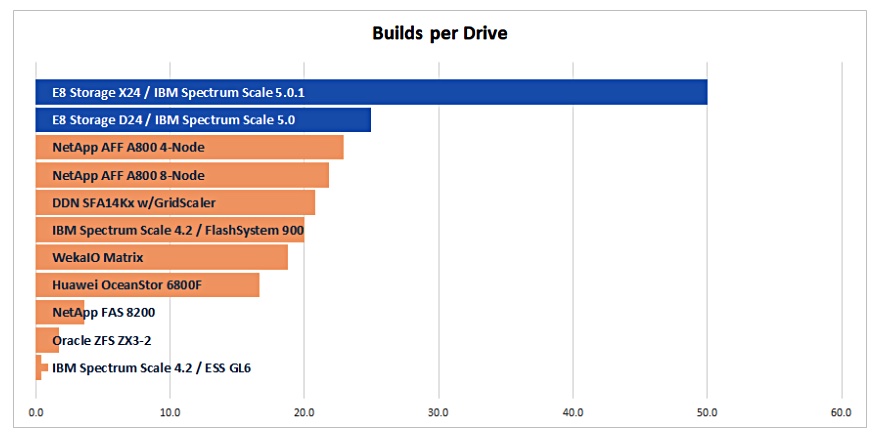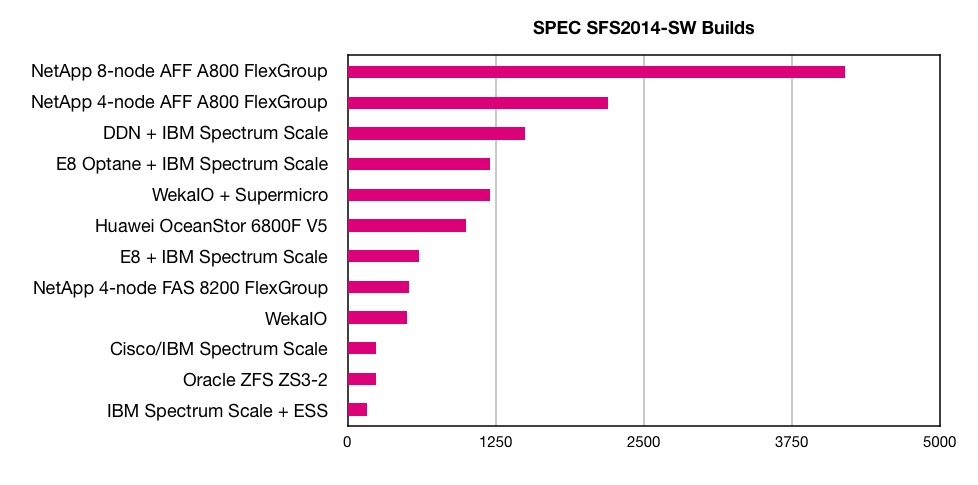Here is a snapshot of press and conference announcements to go with your morning’s coffee, tea, smoothie or some other beverage.
Cohesity goes up the Amazon
Cohesity, a converger of secondary data storage, has its software running inside AWS and using Elastic Block Store (EBS) snapshot APIs to protect cloud-native virtual machines (VMs).
The DataProtect software has auto-discovery and auto-protect capabilities so backups scale automatically as cloud-based workloads are added or deleted. Admins can set backup policies for different virtual machines (VMs) that automatically match different service level agreement (SLA) requirements.
On-premises Cohesity deployments can use AWS for disaster recovery, with fail-over and fail-back capabilities. If there is a data center outage then automated policies activate backup VMs on AWS and then bring the workloads back to the original location when the incident is over.
The on-premises Cohesity can also pump data, via policy-based protection tasks, into Amazon’s Snowball data collection device, used to transfer large amounts of data into AWS.
E8 and SPEC SFS 2014
We received this note from Julie Herd, Director of Technical Marketing for E8: “We were looking at your [NetApp SPEC SFS 2014] article and the latest SPEC results, and agree that having a $ metric as part of the results would be interesting.
“One derived metric that we thought might be interesting to look at is builds / drive as a (very) rough indicator to show the usage efficiency of the media.

“Just a thought, not sure if you think it would be useful, but wanted to provide it to you. The graph includes all of the results (HDD+SSD) except for the Weka IO AWS results since that doesn’t report the drives attached on the AWS instance.”
Interesting idea. As a reminder here is the chart of recent supplier SW Build scores from the SPEC SFS 2914 benchmark.

Perhaps we’ll see E8 have another run at the benchmark using more media and getting a higher result.
HPE OEMs Cohesity
HPE is OEMing Cohesity’s data management software. This converges secondary data onto master copies which can be used to furnish data sets for analytics, test and dev and other purposes.
Cohesity has been certified for use on HPE Apollo and ProLiant server offerings. Mohit Aron, CEO of Cohesity, said HPE has “committed sales, marketing, and technical support resources,” to bring the joint offering to market.
HPE and Cohesity quote Vanson Bourne research that shows over a third of organizations use six or more products for secondary data operations and 10 per cent use 11 or more products. Cohesity claims its single product can replace multiple alternatives, saving customers time, money and management expense.
The joint HPE-Cohesity products are available from HPE and channel partners in Spring 2019. Until then Cohesity software is available through the HPE Complete program.
Red Hat buys NooBaa
Red Hat has bought object storage and inter-cloud transfer startup NooBaa, founded by ex-Exanet and former Dell Fluid File System people in Israel in 2013. It received seed round funding of $2m in 2014, another $2 million in bridge funding in early 2015, and there were two funding events in 2017; the amounts were not revealed.
NooBaa developed object storage software that uses under-utilized compute cores and storage capacity on x86 servers and desktops in a customer’s data centres and makes it accessible as an S3-like cloud service. In late 2016 it announced a bridge between this and Microsoft Azure’s blob store, using an S3 interface to move data to and from Azure,
This technology was developed as an abstraction layer across multiple public clouds and the on-premises world so users could move and manage data in a hybrid environment. It will be used by Red Hat alongside its OpenShift Container Platform, Open Shift Container Storage and Ceph Storage.
The acquisition cost was not disclosed.
Where did the somewhat odd company name of NooBaa come from? The founders wanted to register a web domain of noob.com, as they were noobs, newcomers. It was already taken so they went with NooBaa as an alternative from GoDaddy. Now you know.
One thought: IBM”s investigations when it bought Red Hat for $34bn must have revealed this pending NooBaa acquisition and it was, presumably, approved by IBM.
People on the move
Cloudian has appointed Lenovo executive John Majeski as an observer of its board of directors to provide expert perspective and strategy. He heads the Software and Solutions Defined Infrastructure business at Lenovo, focusing on setting overall product strategy and growing market share.
Jeremy Burton, ex-marketing head at Dell, is now the CEO of a stealthy startup called Observe, Inc. It was founded in 2017, and he joined it in October.
Observe’s founder is Antonov Vadim, who was a founding engineer at Snowflake Software, the data warehouse in the cloud company. He calls himself the Crazy Russian on LinkedIn.
The company is based in San Mateo and offers application performance management tools based on a versatile observability platform. Observe will take on competitors such as Dynatrace and Virtual Instruments.
Crunchbase has no listing for it and we have no funding information. LinkedIn lists under a dozen employees.
Mark Long has resigned as Western Digital’s CFO, effective June 1, 2019, to pursue private equity opportunities. Long has been CFO since 2016, and as its chief strategy officer and an EVP from February 2013. He is also the president of Western Digital Capital, an investment fund, and was involved with both the HGST and SanDisk acquisitions.
HCI vendor Scale Computing has announced the appointment of Mark Sproson, as country manager for UK and Ireland. He’ll be responsible for identifying new business, significantly boosting sales, and continuing to grow the company’s channel business, through both new and existing partnerships. Prior to joining Scale Computing, Sproson held sales and partnership roles at Nexsan, Quantum Storage and CA Technologies.
Shorts
Arcserve UDP has been integrated with HCI Market leading Nutanix’ AHV hypervisor. UDP provides agentless backup of Windows and Linux workloads running on Nutanix AHV, and recovery to virtualised and cloud environments such as VMware, AWS, Azure, Hyper-V or AHV itself. Users get protection of physical servers, virtual machines and cloud instances with disaster recovery to AHV using UDP’s Instant VM and Virtual Standby. UDP On AHV will be available in early 2019.
Clifton College, an independent school in the UK with some 2,000 students, is using Arcserve’s UDP for data protection. It has scalable storage for the estimated 5 to 6 TB of data growth every six months and its Recovery Point Objective has shortened from 24 hours to 15 minutes.
Data protector Asigra says its customers are using its Cloud Backup V14 software to prevent ransomware attacks which use attack loops to infiltrate backup data sets. Cloud Backup V14 detects ransomware infections in the backup stream, isolates the infected files, prevents them from being backed up, and notifies the administrator(s). Admin staff can then identify the infected files and remove them before they detonate. Watch a video discussion about this here.
Cobalt Iron, a provider of enterprise data protection SaaS, has been issued a patent (U.S. Patent No. 10133642) for its techniques for presenting views of a backup environment for an organisation on a sub-organisational basis. The new Cobalt Iron patent discloses unique ways to manage and track IT resource usage in complex, multi-tenant environments.
DataDirect Networks (DDN) is collaborating with India’s Council of Scientific Industrial Research – Central Electronics Engineering Research Institute (CSIR-CEERI) to develop systems for AI, machine learning and deep learning. CSIR-CEERI’s customers should get AI as a service from January 2019.
The two will look at producing joint research, solution blueprints, and AI and DL intellectual property related to accelerating performance through data accessibility to computation clusters. CSIR-CEERI’s Naraina Center has a 5 petaFLOP Cluster which uses NVIDIA DGX-1 servers and DDN storage, which will be used to develop and test the the DDN-CSIR-CEERI research, bluepprints and so forth.
Rubrik’s data protection and management software supports Amazon’s S3 Intelligent-Tiering storage class. With this extension low-access rate archive data can be stored more cheaply.
Seagate has sponsored an IDC white paper; The Digitization of the World – From Edge to Core, which says that, while Healthcare currently has the smallest share of the global enterprise datasphere among key industries examined in the study, it is primed to grow the fastest, far surpassing the Media and Entertainment sector and matching the Financial Services sector by 2025. Download the paper here.
Storage Made Easy has integrated Microsoft Office Online with its File Fabric product so that hosted File Fabric users can edit files stored in Amazon S3, Cloudian, Microsoft Azure, Google Cloud Storage or any of the 60+ storage and data clouds supported, directly in the SME File Fabric using Microsoft Office Online.
The SNIA has an “Emerging Memory Poised To Explode” webcast on Dec 11 at 10am PT and afterwards available on demand. The moderator is Alex McDonald and the two presenters are Tom Coughlin of Coughlin Associates and Jim Handy from Objective Analysis; both know what they are talking about and we expect SCM content. Register here.
Veeam’s N2WS business unit introduced Amazon Elastic Block Store (Amazon EBS) snapshot decoupling and and N2WS-enabled Amazon Simple Storage Service (Amazon S3) repository with N2WS Backup & Recovery v2.4 software, claiming customers using it can reduce storage costs by up to 40 per cent. Users, including managed service providers, can choose different storage tiers and reduce costs for data being retained for longer terms.








